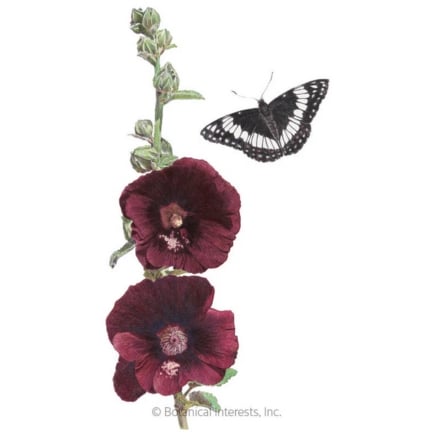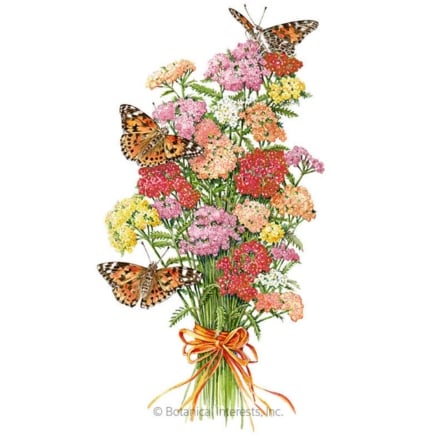Plant These 15 Flowers in May
May is prime planting time, and as we dig in after the final frost and welcome sunshine-filled days, it’s exciting to choose flowers for the garden. In this article, garden expert Katherine Rowe explores favorite spring annuals and perennials to plant in May.
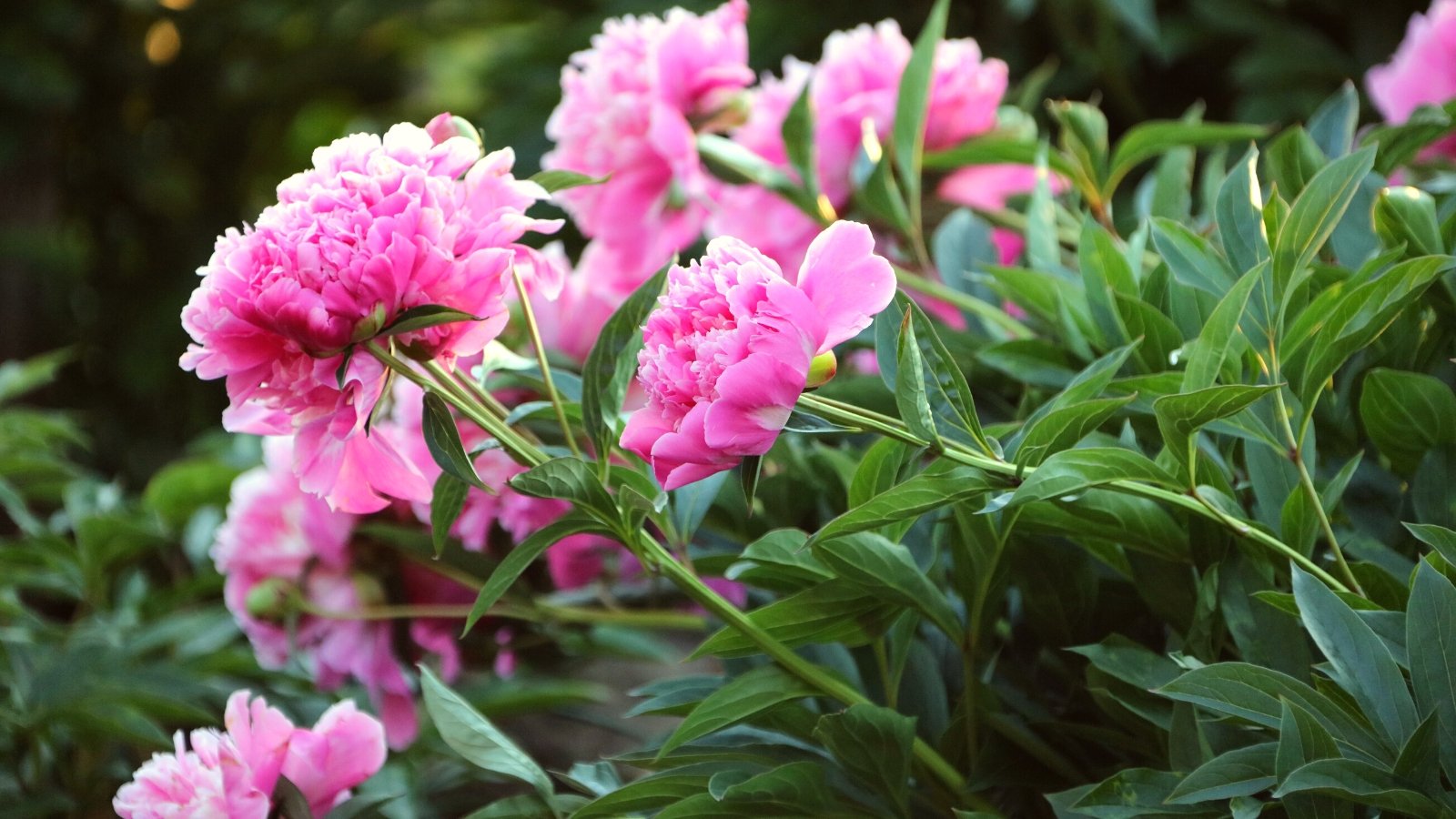
Contents
With May comes the welcome hustle and bustle of planting in the garden. For many of us, it’s a magical time of year! Seeds are going in the ground, and new growth is springing to life. Dormant perennials emerge, and new additions are joining. Warm-season annuals are also ready to nestle into the garden.
May features that sweet spot of temperatures, with cool nights and warming days, ideal for germination and growth flushes. Plants are flowering, and pollinators are busy making their rounds. Options for flowers to plant in May abound. Here, we’ll include a few must-haves and garden favorites for planting this month.
Zinnia

|
|
botanical name Zinnia elegans |
|---|---|
|
|
sun requirements Full sun |
|
|
height 1-3’ |
|
|
hardiness zones 2-11 |
Zinnias bring dynamic color to the annual display with their large, vibrant, double-disc flowers. The blooms range in color from white to magenta to lime and bicolor. Zinnias love the heat and bloom nonstop from early summer through frost. Depending on the variety, plants grow low and mounding or tall and airy.
Zinnias grow easily from seed and make exceptional mass plantings. Plant these flowers in May for the warm-season show. Plants respond well to deadheading and cutting for fresh floral arrangements (and the reward is more blooms!). Zinnias are edible and pretty as garnish for summer beverages and desserts.
For best vigor, zinnias need well-drained soil and full sun. Ensure good air circulation to prevent pests and fungal diseases, especially in humid climates.
Cosmos

|
|
botanical name Cosmos spp. |
|---|---|
|
|
sun requirements Full sun |
|
|
height 1-6’ |
|
|
hardiness zones 2-11 |
Like zinnias, sun-loving cosmos produce colorful blooms throughout the warm season. Ray flowers “float” on tall, airy stems. This summer annual is native to the Americas and lends a wildflower look to the garden. Daisy-like flowers in vivid shades of yellow, apricot, bright pink, lavender, red, and chocolate (and many more) grow easily with little care.
Cosmos reseed naturally and grow in hot, dry conditions with variable soils. They’re unfussy plants, and too much water, fertilizer, and organic richness hinders their vigor.
Grow cosmos quickly from seed in May – the more, the better – for color and to attract pollinators. The delicate flowers make a more significant statement en masse. When flowers finish blooming and go to seed, horticulturalists recommend cutting plants back to 12 to 18 inches. Plants rebloom quickly. Let the cut stems fall in place so new seeds germinate for the next generation of blooms.
Dahlia

|
|
botanical name Dahlia spp. |
|---|---|
|
|
sun requirements Full sun |
|
|
height 3-5’ |
|
|
hardiness zones 7-10 |
Dahlias add drama to the summertime garden as stunning specimens and showy cut flowers. Beautiful, large blooms in an array of colors and petal arrangements make them a garden standout.
Dahlia flowers range in size from tiny pom poms to large dinner plates. Their nearly perfect petal arrangements create symmetrical and varying forms. The American Dahlia Society characterizes dahlias in groups like decorative, ball, orchid, and cactus, all based on petals and shapes of intricate symmetry.
Begin planting dahlias in May, as cool nighttime temperatures and warm days are best for them to grow and flower. On average, 55-60℉ nighttime temperatures and 70-80℉ daytime are ideal. Dahlias grow well as annuals, growing quickly in a single season. In late fall, dig tubers and store them in winter for replanting in the spring, or start with fresh plants.
Pair dahlias with geranium, agastache, salvia, and spring-blooming bulbs. Dahlias grow best in full sun with evenly moist, well-drained soils. While they tolerate partial shade, full sun increases plant vigor and flowering. They are toxic to dogs and cats, so keep them out of range of curious pets.
Hollyhock

|
|
botanical name Alcea rosea |
|---|---|
|
|
sun requirements Full sun |
|
|
height 3-8’ |
|
|
hardiness zones 3-9 |
Hollyhocks are old-fashioned garden biennials or short-lived perennials with stunning summer blooms along tall, straight stems. They grow in gorgeous colors, from heirloom varieties of velvety black to magenta, carmine, and pale yellow.
Hollyhocks are dramatic garden additions both in stature and color. Some varieties reach eight feet tall! Those with large bloom stalks benefit from staking and wind protection. Shorter varieties start at three feet tall and are self-supporting. Hollyhocks are perfect for the cutting garden and the back of the border.
Hollyhocks grow best in full sun with moist, rich soils. They grow quickly from seed after the last frost date, making them an ideal flower to plant in May, depending on your zone. They reseed vigorously, so only grow them if you don’t mind some new plants each year!
Peony

|
|
botanical name Paeonia officinalis |
|---|---|
|
|
sun requirements Full sun |
|
|
height 2-4’ |
|
|
hardiness zones 3-9 |
The beloved peony flower is among the most decadent in the garden. Its lush petals are pink, white, red, and yellow shades. Peonies are cold-hardy perennials that bloom once a season, from late spring to early summer.
Peonies grow in three forms (for a succession of blooms and interest, plant a combination of peonies). Herbaceous peonies include the common garden peony and those that die back to the ground in winter. Tree peonies are woody, multi-stemmed shrubs, and woodland peonies are more suited to shade, some with ferny foliage.
Because of their full flowers, peonies may need staking or caging. Grow peonies in full sun (except woodland peonies), giving afternoon protection from direct rays. They grow best in mild to cool climates.
Marigolds
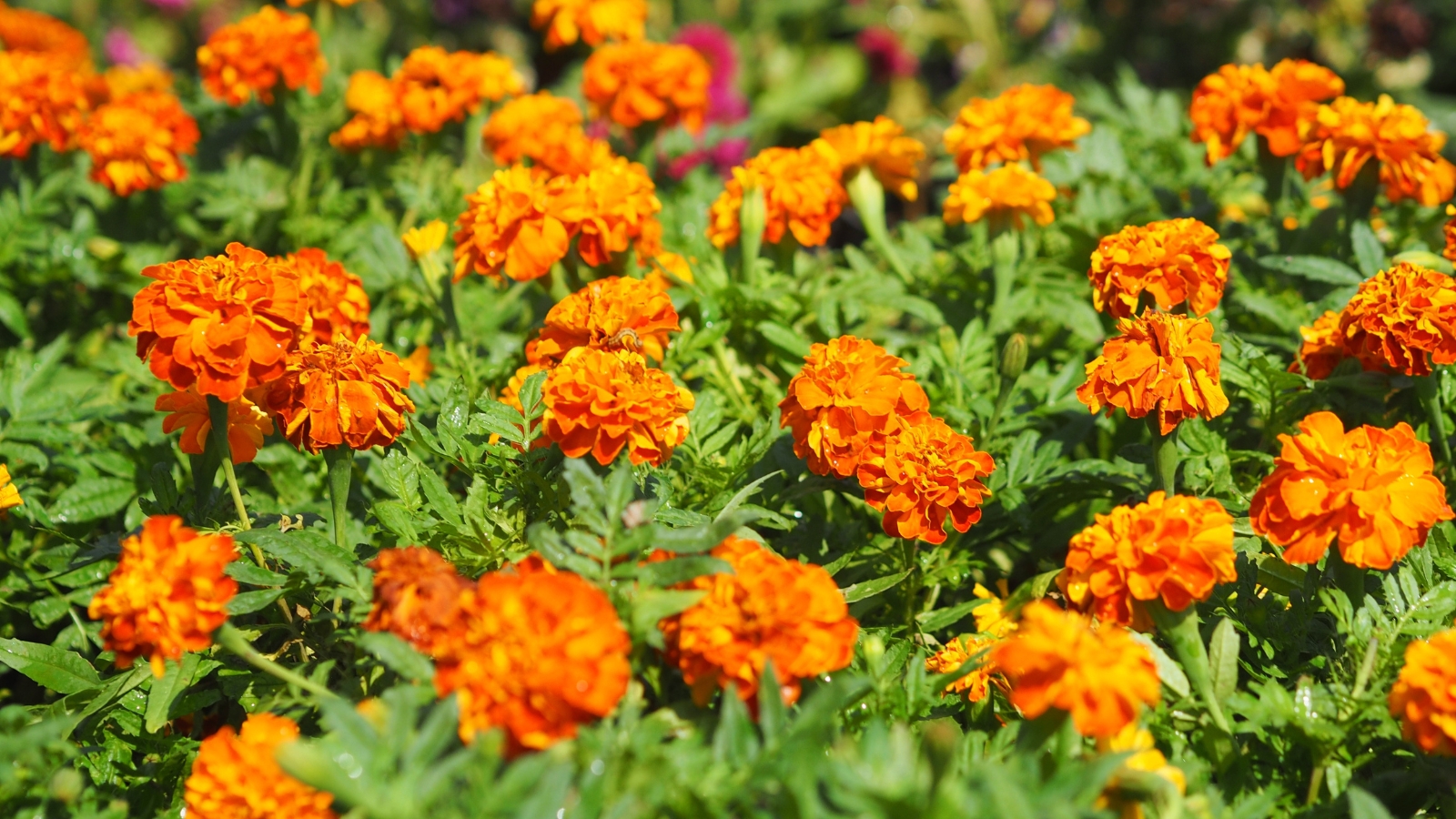
|
|
botanical name Tagetes spp. |
|---|---|
|
|
sun requirements Full sun |
|
|
height 6”-3’ |
|
|
hardiness zones 2-11 |
Marigolds’ prolific blooms in sunny yellow, deep gold, creamy white, and rich garnet contrast beautifully with their feathery deep green or purple foliage. They bloom reliably all summer and make beneficial companion plants in the vegetable garden. Their showy pom-pom flowers brighten the annual flower display with continual color.
There are three types of marigolds:
- French marigolds (Tagetes patula) produce bountiful blooms in single or double flowers up to two inches wide.
- African marigolds (Tagetes erecta) reach three to four feet tall and perennialize in moderate climates.
- Signet marigolds (Tagetes tenuifolia) are the most petite marigolds and also the tastiest.
Marigolds charm with their fragrance, cheerful color, and versatility as fresh and dried blooms. They grow quickly from seed and thrive until heavy frost. Grow marigolds in full sun with well-drained soils. Amend soils with organic matter at planting time if soils are lean.
Yarrow
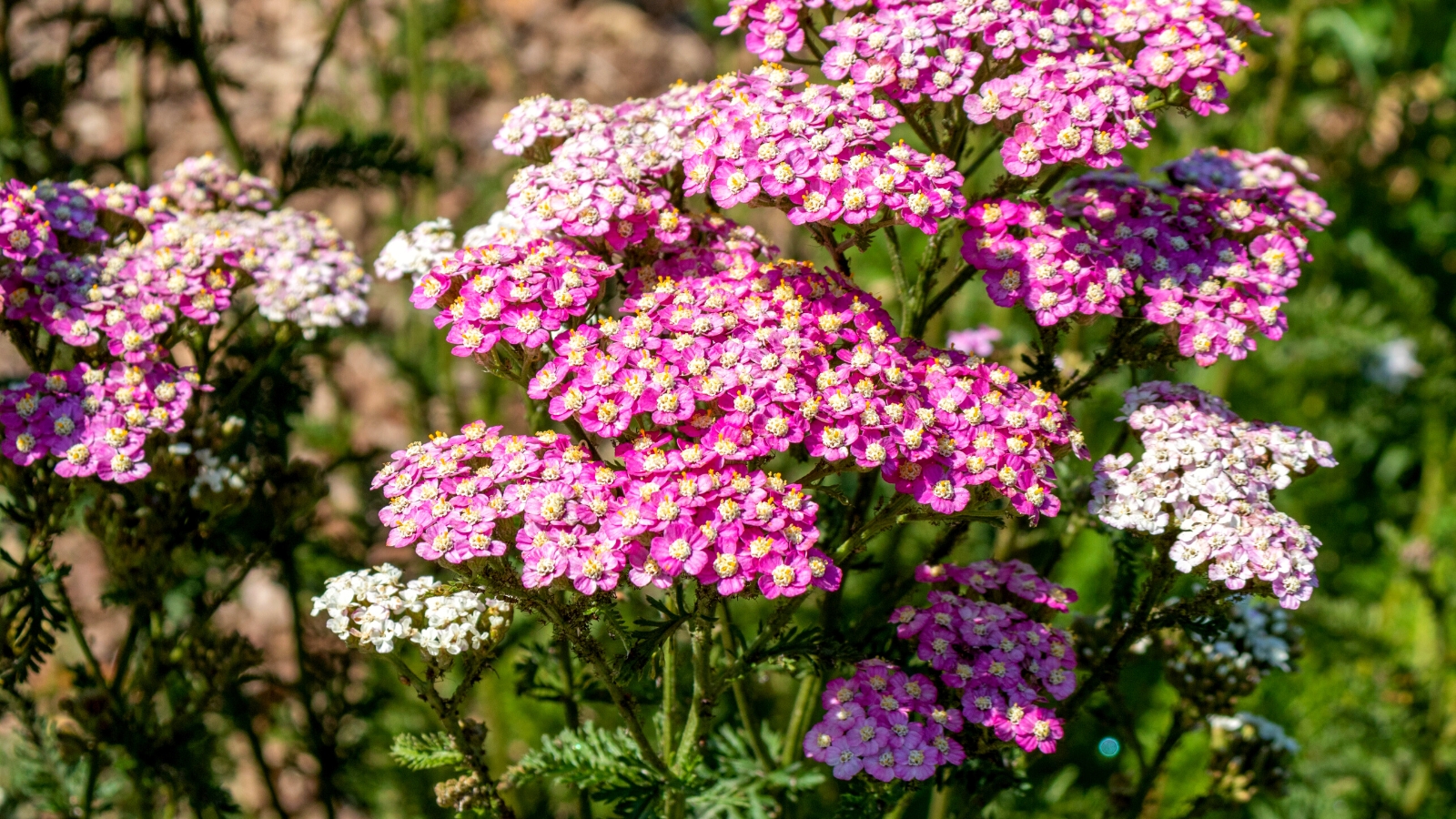
|
|
botanical name Achillea millefolium |
|---|---|
|
|
sun requirements Full sun |
|
|
height 1-3’ |
|
|
hardiness zones 3-9 |
Yarrow is a native North American perennial with large, flat flower clusters that rise above feathery, fernlike foliage. It thrives in the heat, making it a good partner for zinnias and cosmos. Planting these flowers in May gives plants time to establish a strong root system before summer’s heat.
The classic A. millefolium features sunshine-yellow bloom clusters on tall stems. Many outstanding yarrow cultivars are available in varying heights and colors, from apricot to pink to scarlet. Yarrow brings feathery texture and vivid tones to the garden, and the broad flower heads are pollinator magnets.
Sun-loving yarrow is low-maintenance and drought-tolerant. Like many natives, yarrow doesn’t need fertilizer or rich organic soil to thrive. It requires a sunny spot and soil with good drainage to flourish. Ruggedly adaptable, yarrow is an easy-care grower that benefits the garden.
Aster

|
|
botanical name Aster spp. |
|---|---|
|
|
sun requirements Full sun |
|
|
height Varies |
|
|
hardiness zones 3-8 |
Asters, native to North America, are garden mainstays with deep blue, lavender, and pink daisy-like flowers. Aster, Greek for “star,” produces clusters of star flowers that cover plants in a blanket of color.
Asters put on a showy display well into fall as other blooming plants begin to fade. Late-season blooms support pollinators during the seasonal transition from summer to fall.
Asters prefer consistently moist, organically rich soils. Allow good air circulation and ensure soils have good drainage to prevent foliar diseases.
Echinacea
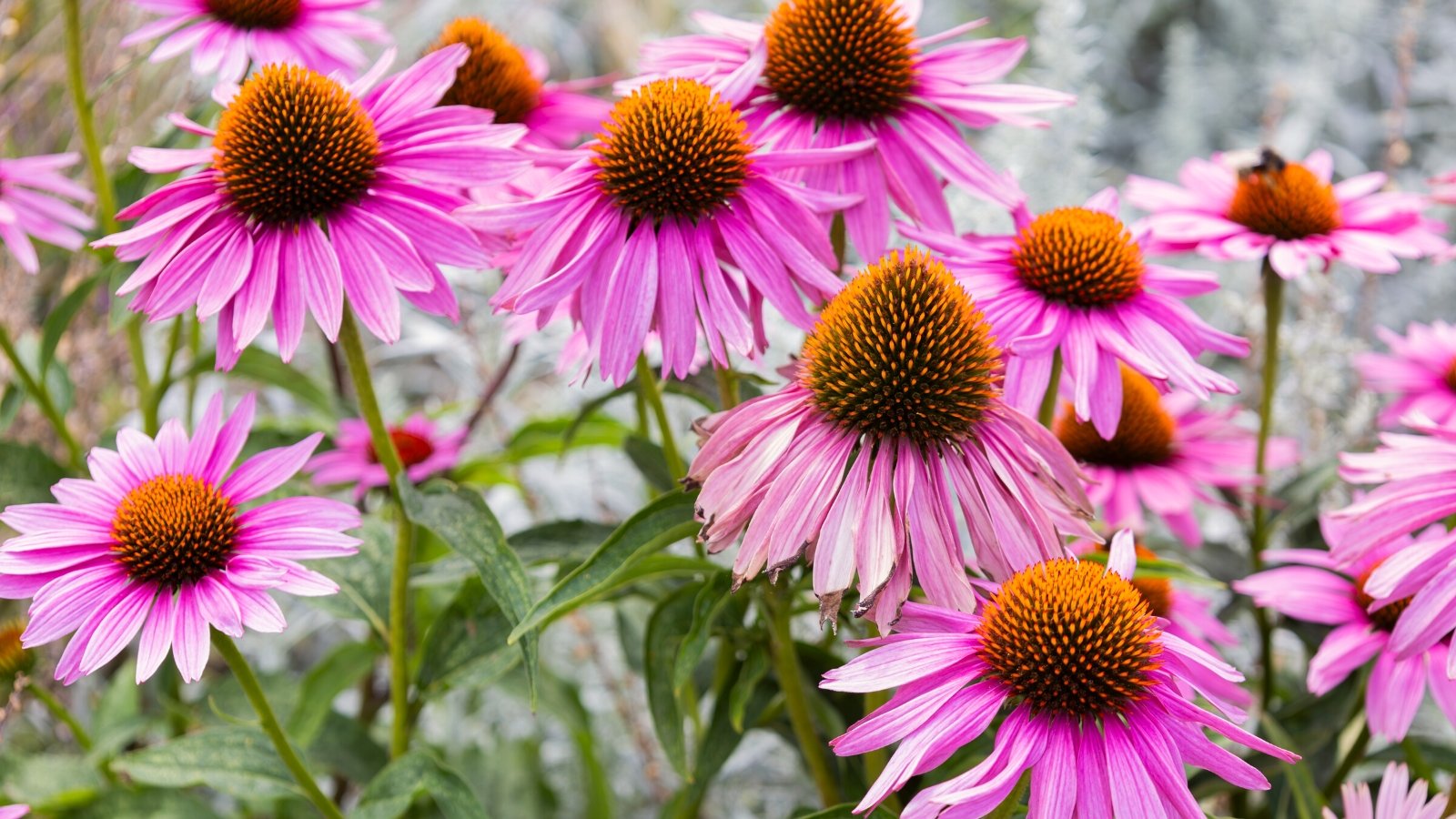
|
|
botanical name Echinacea purpurea |
|---|---|
|
|
sun requirements Full sun |
|
|
height 1.5-5’ |
|
|
hardiness zones 3-9 |
Echinacea, or purple coneflower, is a quintessential landscape native. Echinacea is a natural prairie plant and a carefree perennial with showy blooms undaunted by less-than-ideal growing conditions. Long, purple ray petals surround orange disc florets. The flowers provide valuable nectar for beneficial insects, and pollinators abound when echinacea blooms.
Coneflower cultivars offer an array of colors and forms. They thrive in the summer heat and full sun in well-draining soils.
Deadhead as you’d like during the growing season, but let flowers go to seed in the fall. The dried seed heads provide food for foraging birds and extend winter interest in the garden. The fallen and dispersed seeds overwinter to join the subsequent blooming season.
Iris
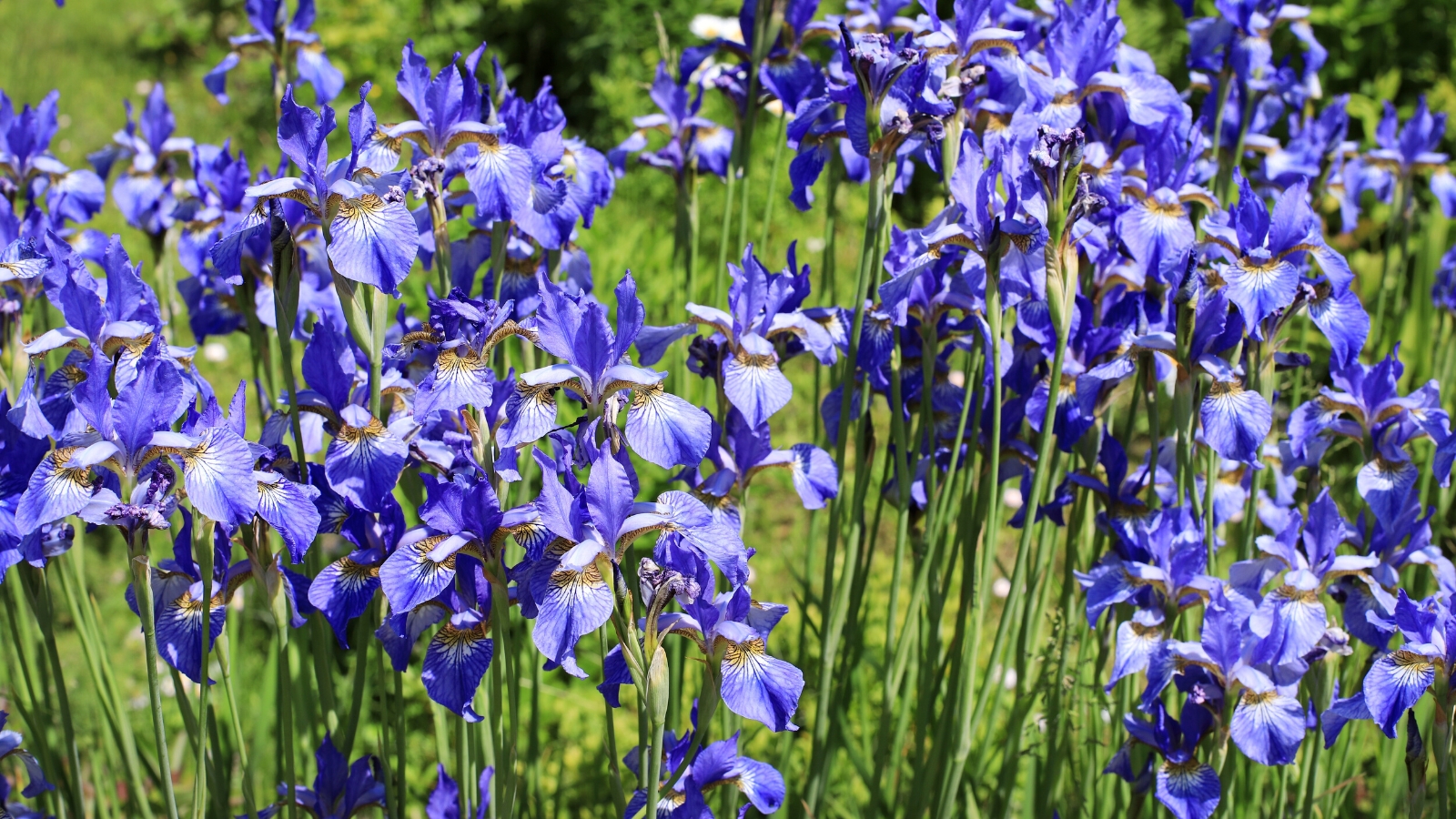
|
|
botanical name Iris spp. |
|---|---|
|
|
sun requirements Full sun to partial shade |
|
|
height 6-48” |
|
|
hardiness zones 4-9 |
With nearly 300 species of Iris and thousands of cultivars, these blooming perennials span the spectrum in color, form, and size. No wonder they bear the name of the Goddess of the Rainbow, Iris. These blooms sprung up wherever her feet touched the ground and in a myriad of colors.
Popular garden selections include bearded iris, crested iris, Siberian iris, Japanese iris, and sweet iris. Each brings vertical interest to the garden with distinct flower forms of three upper and three lower petals (falls). Petals range from broad and ruffled to narrow and strappy with solid tones, stripes, and painterly details.
Irises grow best in organically rich soils with consistent moisture (though some readily adapt to varying conditions). Every few years, divide irises to thin the colonies, as crowding reduces flowering. Replant the divided rhizomes to expand the collection.
Salvia
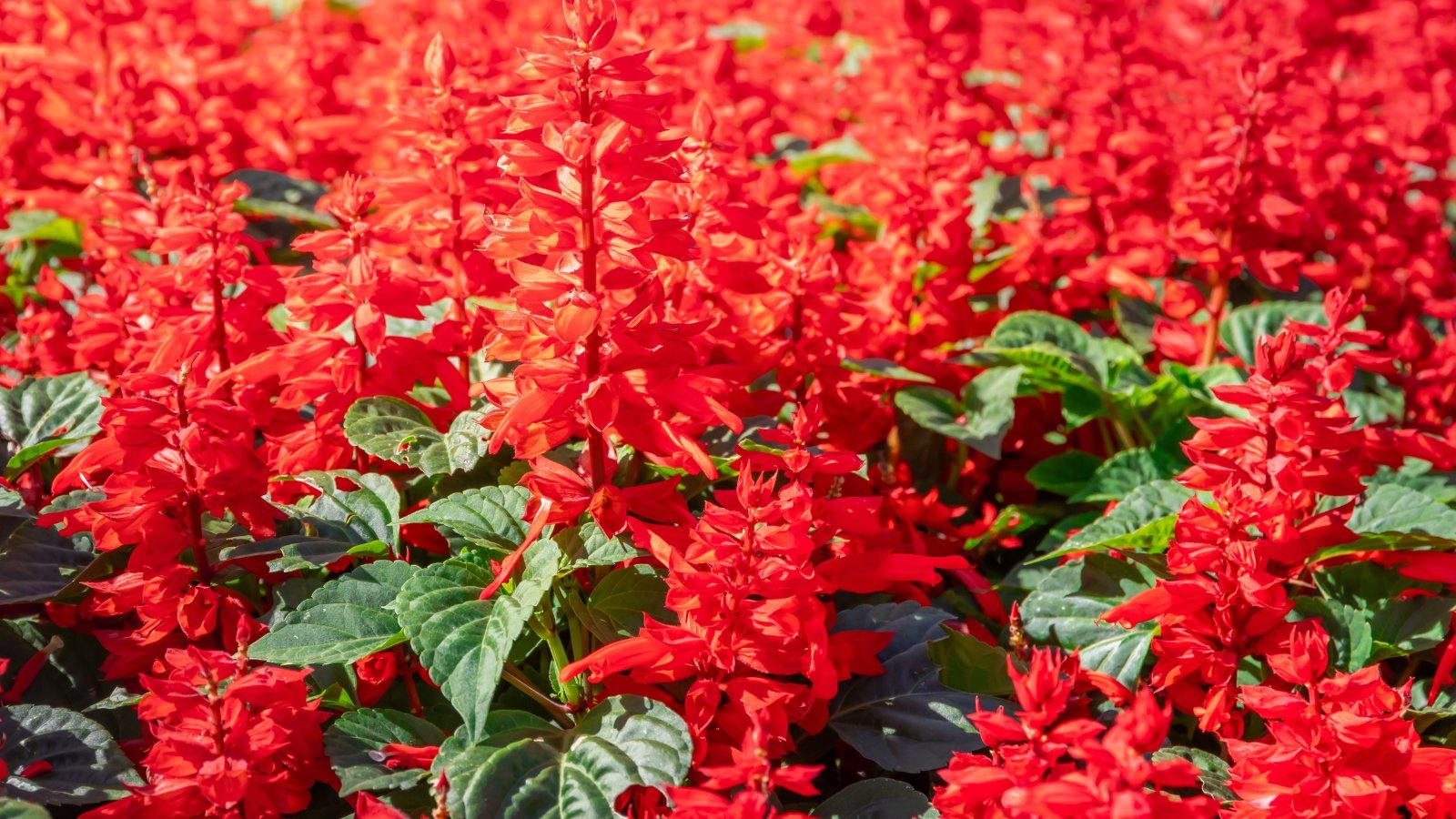
|
|
botanical name Salvia spp. |
|---|---|
|
|
sun requirements Full sun to partial shade |
|
|
height 1-5’ |
|
|
hardiness zones 3-9 |
With so many salvias to love, the challenge may be whittling down the number to plant. Salvia, also called sage, encompasses over 400 different species and varieties, bringing an array of colors and forms to planting arrangements. Its vibrant, tubular blooms attract pollinators.
One of the first to bloom in spring (and a great flower to plant in May) is Salvia sylvestris ‘May Night.’ It flowers abundantly in deep violet spires through early summer with a compact, mounding habit that makes it a good fit for a pot or garden border.
Salvia guaranitica ‘Black and Blue’ is a favorite native salvia, performing well in partial shade with tall, deep blue tubular flowers through fall. For a smaller option, Salvia leucantha ‘Santa Barbara’ features a compact habit of Mexican bush sage with bright purple blooms in late summer through fall.
Salvia thrives in hot, dry conditions; most prefer full sun to partial shade. Salvia elegans (pineapple sage) grows beautifully in full shade.
They are easy-care plants with low maintenance requirements. Provide well-draining soil and water during dry spells (allowing soils to dry out slightly between watering).
Hardy Geraniums
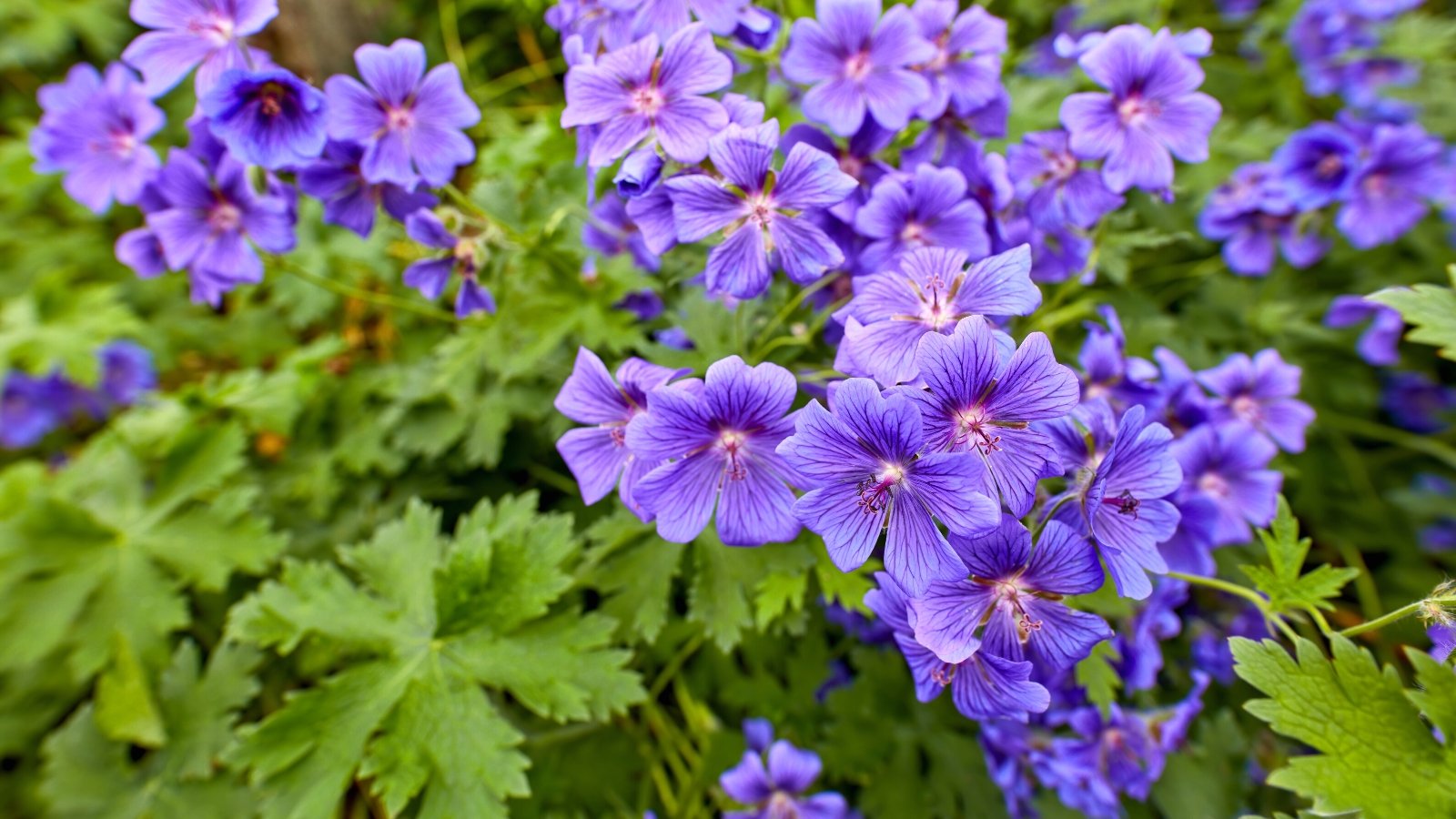
|
|
botanical name Geranium spp. |
|---|---|
|
|
sun requirements Full sun to partial shade |
|
|
height 1-2’ |
|
|
hardiness zones 3-8 |
Hardy geraniums, or cranesbill, are tough perennials with ample foliage and delicate flowers in rich colors. They include native woodland species (Geranium maculatum), that form a soft, mounding specimen with spring and early summer flowers. Attractive leaves are palmately lobed in a fresh, true green.
Geranium ‘Rozanne’ is a top-performing hybrid with bright purple-blue flowers from spring until frost. For its long bloom time and vigor, ‘Rozanne’ won the Perennial Plant Association’s Perennial Plant of the Year award. It is hardy in USDA zones 5-8.
Hardy geraniums grow best in organically rich soils with even moisture, where they’ll naturalize under optimal conditions (but aren’t aggressive or invasive). Plants are low-maintenance and don’t require deadheading.
Shasta Daisy

|
|
botanical name Leucanthemum x superbum |
|---|---|
|
|
sun requirements Full sun to partial shade |
|
|
height 1-4’ |
|
|
hardiness zones 4-9 |
Daisies welcome the warm season with cheerful faces of white petals and bright yellow centers. Shasta daisies, the crisp, old-fashioned beauties, feature large, bright ray blooms in spring and summer. They brighten the perennial border in single and double-flowered varieties. Deep, glossy green basal foliage contrasts the clear blooms.
Different varieties of shasta feature varying flower forms and plant sizes. Shasta daisies are a good fit for pollinator gardens, cutting gardens, perennial beds, cottage gardens, and small spaces. They lend a wildflower look but with a tidy habit.
Shasta daisies hit their peak bloom in mid-summer and are an ideal flower to plant in the cool temperatures of May. They do best in full sun in average soils, as long as it’s well-draining soil. In humid climates, look to ‘Becky’, a larger plant boasting excellent disease resistance to fungal rot and leaf spot.
Lavender

|
|
botanical name Lavandula spp. |
|---|---|
|
|
sun requirements Full sun |
|
|
height 3’ |
|
|
hardiness zones 5-8 |
There’s nothing like lavender, with its refreshing fragrance, purple bloom spikes, silvery foliage, and many uses, from cleansing to culinary. Whether it’s one of the many English, French, Spanish, or Dutch varieties, lavender makes a showy, evergreen focal point.
This sun-loving Mediterranean plant grows naturally in arid, warm summers and cool winters. If your climate experiences cold winters, look for hardy varieties like Lavendula angustifolia ‘Munstead,’ an early bloomer with a compact habit. Lavender performs beautifully in a sunny container and overwinters in a sheltered spot.
Low-maintenance lavender grows best in full sun with well-drained soils. Soils should dry slightly between waterings. Lavender’s natural climate is dry, and plants tolerate periods of drought. Look to ‘Phenomenal’ lavender in humid climates for increased resistance.
Sunflowers
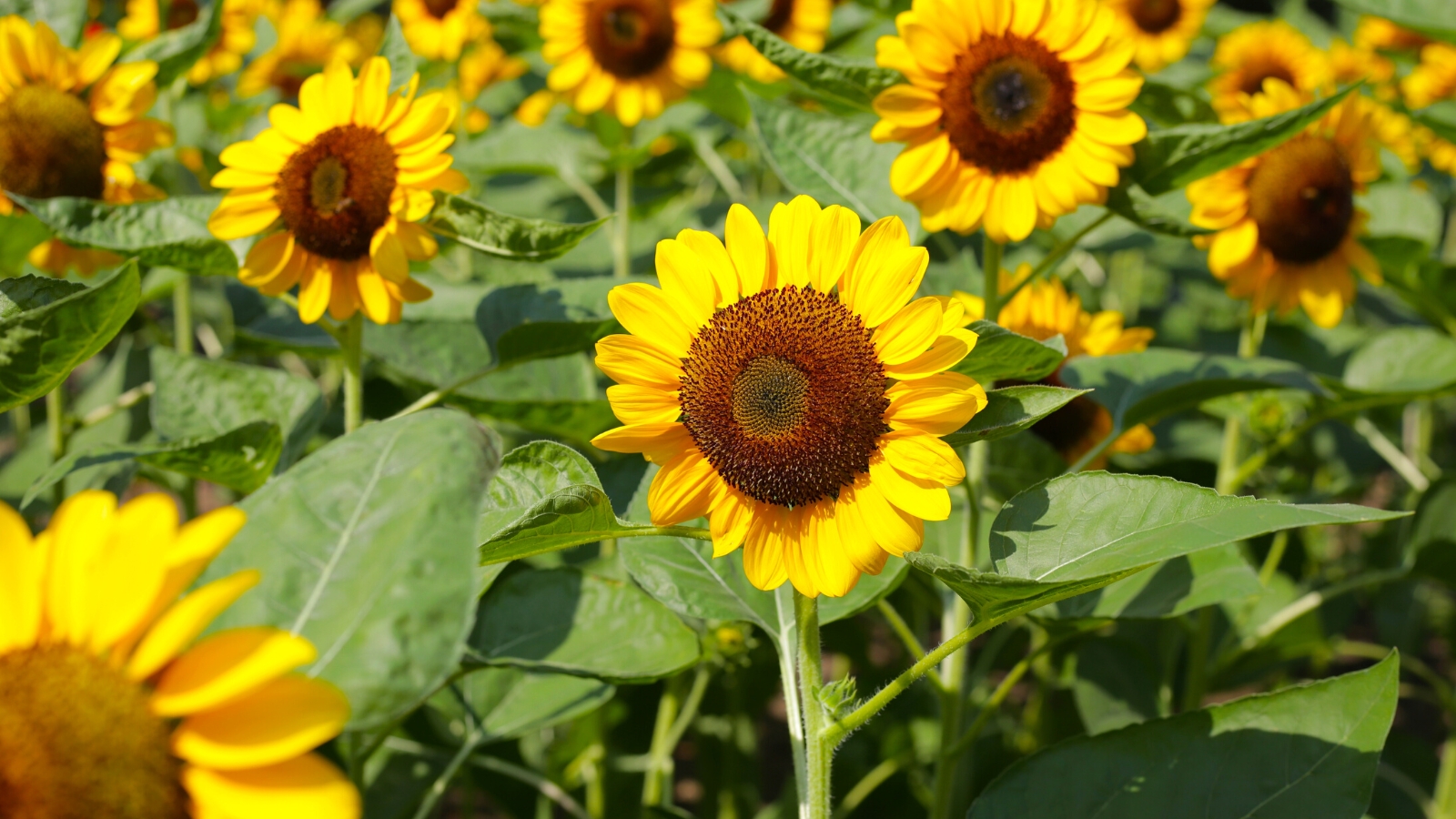
|
|
botanical name Helianthus spp. |
|---|---|
|
|
sun requirements Full sun |
|
|
height 1-15’ |
|
|
hardiness zones 2-11 |
Give sunflowers a sunny spot in the garden, and they’ll happily brighten it. May is perfect for planting sunflowers, as they grow quickly from seed. Direct sow seeds starting one to weeks after the final frost.
Sunflowers come in various sizes and colors, from dwarf and fuzzy yellow to tall and creamy lemon. These stately flowers bring bold interest in color and form. Prolific seeds emerge after blooms fade on standing stalks, making sunflowers an excellent food source for songbirds and small mammals.
To maximize their impact, plant sunflowers in groups and seed two to three successional plantings so that when one group fades, another takes its place.
Sunflowers bloom from summer into fall, matching the harvest palette in every shade of yellow, orange, garnet, and cream. Their vibrant faces and nodding heads represent the quintessential American flower and iconic bloom.
Final Thoughts
Hopefully, your April showers have led to May flowers! While spring is unpredictable, many of us are in the spring transition from cool to warm temperatures with the final frost in hindsight.
May marks ideal planting and growing conditions with its cool nights and sunny days. Cool-season plants are flushing and flowering, and new plantings are ready to get established and take off in the warm season. Enjoy planting your favorite May flowers and enjoy the rewards this month and beyond.

